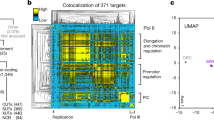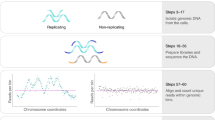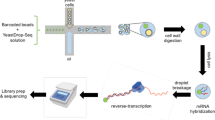Abstract
We used high-density oligonucleotide microarrays to analyse the genomes and meiotic expression patterns of two yeast strains, SK1 and W303, that display distinct kinetics and efficiencies of sporulation. Hybridization of genomic DNA to arrays revealed numerous gene deletions and polymorphisms in both backgrounds. The expression analysis yielded approximately 1,600 meiotically regulated genes in each strain, with a core set of approximately 60% displaying similar patterns in both strains. Most of these (95%) are MATa/MATα-dependent and are not similarly expressed in near-isogenic meiosis-deficient controls. The transcript profiles correlate with the distribution of defined meiotic promoter elements and with the time of known gene function.
This is a preview of subscription content, access via your institution
Access options
Subscribe to this journal
Receive 12 print issues and online access
$209.00 per year
only $17.42 per issue
Buy this article
- Purchase on Springer Link
- Instant access to full article PDF
Prices may be subject to local taxes which are calculated during checkout







Similar content being viewed by others
References
Kupiec, M., Byers, B., Esposito, R.E. & Mitchell, A.P. Meiosis and sporulation. in Saccharomyces cerevisiae 889–1036 (Cold Spring Harbor Laboratory Press, Cold Spring Harbor, 1997).
Freire, R. et al. Human and mouse homologs of Schizosaccharomyces pombe rad1(+) and Saccharomyces cerevisiae RAD17: linkage to checkpoint control and mammalian meiosis. Genes Dev. 12, 2560–2573 (1998).
McKim, K.S. & Hayashi-Hagihara, A. mei-W68 in Drosophila melanogaster encodes a Spo11 homolog: evidence that the mechanism for initiating meiotic recombination is conserved. Genes Dev. 12, 2932–2942 (1998).
Edelmann, W. et al. Mammalian MutS homologue 5 is required for chromosome pairing in meiosis. Nature Genet. 21, 123–127 (1999).
Zalevsky, J., MacQueen, A., Duffy, J., Kemphues, K. & Villeneuve, A. Crossing over during Caenorhabditis elegans meiosis requires a conserved MutS-based pathway that is partially dispensable in budding yeast. Genetics 153, 1271–1283 (1999).
Mitchell, A.P. Control of meiotic gene expression in Saccharomyces cerevisiae. Microbiol. Rev. 58, 56–70 (1994).
Strich, R. et al. UME6 is a key regulator of nitrogen repression and meiotic development. Genes Dev. 8, 796–810 (1994).
Anderson, S.F., Steber, C.M., Esposito, R.E. & Coleman, J.E. UME6, a negative regulator of meiosis in Saccharomyces cerevisiae, contains a C-terminal Zn2Cys6 binuclear cluster that binds the URS1 DNA sequence in a zinc-dependent manner. Protein Sci. 4, 1832–1843 (1995).
Bowdish, K.S., Yuan, H.E. & Mitchell, A.P. Positive control of yeast meiotic genes by the negative regulator UME6. Mol. Cell. Biol. 15, 2955–2961 (1995).
Steber, C.M. & Esposito, R.E. UME6 is a central component of a developmental regulatory switch controlling meiosis-specific gene expression. Proc. Natl Acad. Sci. USA 92, 12490–12494 (1995).
Rubin-Bejerano, I., Mandel, S., Robzyk, K. & Kassir, Y. Induction of meiosis in Saccharomyces cerevisiae depends on conversion of the transcriptional represssor Ume6 to a positive regulator by its regulated association with the transcriptional activator Ime1. Mol. Cell. Biol. 16, 2518–2526 (1996).
Gailus-Durner, V., Xie, J., Chintamaneni, C. & Vershon, A.K. Participation of the yeast activator Abf1 in meiosis-specific expression of the HOP1 gene. Mol. Cell. Biol. 16, 2777–2786 (1996).
Ozsarac, N., Straffon, M.J., Dalton, H.E. & Dawes, I.W. Regulation of gene expression during meiosis in Saccharomyces cerevisiae: SPR3 is controlled by both ABFI and a new sporulation control element. Mol. Cell. Biol. 17, 1152–1159 (1997).
Chu, S. & Herskowitz, I. Gametogenesis in yeast is regulated by a transcriptional cascade dependent on Ndt80. Mol. Cell 1, 685–696 (1998).
Hepworth, S.R., Friesen, H. & Segall, J. NDT80 and the meiotic recombination checkpoint regulate expression of middle sporulation-specific genes in Saccharomyces cerevisiae. Mol. Cell. Biol. 18, 5750–5761 (1998).
Surosky, R.T. & Esposito, R.E. Early meiotic transcripts are highly unstable in Saccharomyces cerevisiae. Mol. Cell. Biol. 12, 3948–3958 (1992).
Chu, S. et al. The transcriptional program of sporulation in budding yeast. Science 282, 699–705 (1998).
Winzeler, E.A. et al. Direct allelic variation scanning of the yeast genome. Science 281, 1194–1197 (1998).
Padmore, R., Cao, L. & Kleckner, N. Temporal comparison of recombination and synaptonemal complex formation during meiosis in S. cerevisiae. Cell 66, 1239–1256 (1991).
Cho, R.J. et al. A genome-wide transcriptional analysis of the mitotic cell cycle. Mol. Cell 2, 65–73 (1998).
Wodicka, L., Dong, H., Mittmann, M., Ho, M.H. & Lockhart, D.J. Genome-wide expression monitoring in Saccharomyces cerevisiae. Nature Biotechnol. 15, 1359–1367 (1997).
Eisen, M.B., Spellman, P.T., Brown, P.O. & Botstein, D. Cluster analysis and display of genome-wide expression patterns. Proc. Natl Acad. Sci. USA 95, 14863–14868 (1998).
Atcheson, C.L., DiDomenico, B., Frackman, S., Esposito, R.E. & Elder, R.T. Isolation, DNA sequence, and regulation of a meiosis-specific eukaryotic recombination gene. Proc. Natl Acad. Sci. USA 84, 8035–8039 (1987).
Buckingham, L.E. et al. Nucleotide sequence and promoter analysis of SPO13, a meiosis-specific gene of Saccharomyces cerevisiae. Proc. Natl Acad. Sci. USA 87, 9406–9410 (1990).
Briza, P., Breitenbach, M., Ellinger, A. & Segall, J. Isolation of two developmentally regulated genes involved in spore wall maturation in Saccharomyces cerevisiae. Genes Dev. 4, 1775–1789 (1990).
Dorsman, J.C. et al. An ARS/silencer binding factor also activates two ribosomal protein genes in yeast. Nucleic Acid Res. 17, 4917–4923 (1989).
Della Seta, F., Treich, I., Buhler, J.M. & Sentenac, A. ABF1 binding sites in yeast RNA polymerase genes. J. Biol. Chem. 265, 15168–15175 (1990).
Planta, R.J., Goncalves, P.M. & Mager, W.H. Global regulators of ribosome biosynthesis in yeast. Biochem. Cell Biol. 73, 825–834 (1995).
Rolfes, R.J., Zhang, F. & Hinnebusch, A.G. The transcriptional activators BAS1, BAS2, and ABF1 bind positive regulatory sites as the critical elements for adenine regulation of ADE5,7. J. Biol. Chem. 272, 13343–13354 (1997).
Pierce, M. et al. Transcriptional regulation of the SMK1 mitogen-activated protein kinase gene during meiotic development in Saccharomyces cerevisiae. Mol. Cell. Biol. 18, 5970–5980 (1998).
Sumrada, R.A. & Cooper, T.G. Ubiquitous upstream repression sequences control activation of the inducible arginase gene in yeast. Proc. Natl Acad. Sci. USA 84, 3997–4001 (1987).
Sweet, D.H., Jang, Y.K. & Sancar, G.B. Role of UME6 in transcriptional regulation of a DNA repair gene in Saccharomyces cerevisiae. Mol. Cell. Biol. 17, 6223–6235 (1997).
Hepworth, S.R., Ebisuzaki, L.K. & Segall, J. A 15-base-pair element activates the SPS4 gene midway through sporulation in Saccharomyces cerevisiae. Mol. Cell. Biol. 15, 3934–3944 (1995).
Ross-Macdonald, P. et al. Large-scale analysis of the genome by transposon tagging and gene disruption. Nature 402, 413–418 (1999).
Dujon, B. European Functional Analysis Network (EUROFAN) and the functional analysis of the Saccharomyces cerevisiae genome. Electrophoresis 19, 617–624 (1998).
Covitz, P.A. & Mitchell, A.P. Repression by the yeast meiotic inhibitor RME1. Genes Dev. 7, 1598–1608 (1993).
Esposito, M.S. & Esposito, R.E. The genetic control of sporulation in Saccharomyces. I. The isolation of temperature-sensitive sporulation-deficient mutants. Genetics 61, 79–89 (1969).
Esposito, R.E. & Klapholz, S. Meiosis and ascospore development. in The Molecular Biology of the Yeast Saccharomyces: Life Cycle and Inheritance (eds Stratern, J.N., Jones, E.W. & Broach, J.R.) 211–287 (Cold Spring Harbor Laboratory Press, Cold Spring Harbor, 1981).
Kaback, D.B. & Feldberg, L.R. Saccharomyces cerevisiae exhibits a sporulation-specific temporal pattern of transcript accumulation. Mol. Cell. Biol. 5, 751–761 (1985).
Strich, R., Woontner, M. & Scott, J. Mutations in ARS1 increase the rate of simple loss of plasmids in Saccharomyces cerevisiae. Yeast 2, 169–178 (1986).
Klapholz, S., Waddell, C.S. & Esposito, R.E. The role of the SPO11 gene in meiotic recombination in yeast. Genetics 110, 187–216 (1985).
Bishop, D.K., Park, D., Xu, L. & Kleckner, N. DMC1: a meiosis-specific yeast homolog of E. coli recA required for recombination, synaptonemal complex formation, and cell cycle progression. Cell 69, 439–456 (1992).
Lockhart, D.J. et al. Expression monitoring by hybridization to high-density oligonucleotide arrays. Nature Biotechnol. 14, 1675–1680 (1996).
Acknowledgements
We thank L.H. Rutkowski and B.K. Washburn for critical reading of the manuscript; S. Fuller for on-line support of GeneSpring; J. Clark, C. Sarrauste de Menthière and B. Masdoua for help in designing the web sites and constructing the database; and J. Demaille, A. Fernandez and N. Lamb at the IGH for hosting M.P. during the final stages of the data analysis. This work was supported by NIH grants 1R01GM29182 (to R.E.E.) and 1RO1HG01633 (to R.W.D.). M.P. was supported by a Max Kade postdoctoral fellowship and in part by grant RG0533 (to A.F. and N.L.).
Author information
Authors and Affiliations
Corresponding author
Rights and permissions
About this article
Cite this article
Primig, M., Williams, R., Winzeler, E. et al. The core meiotic transcriptome in budding yeasts. Nat Genet 26, 415–423 (2000). https://doi.org/10.1038/82539
Received:
Accepted:
Issue Date:
DOI: https://doi.org/10.1038/82539
This article is cited by
-
Nitrogen nutrition contributes to plant fertility by affecting meiosis initiation
Nature Communications (2022)
-
High-resolution analysis of cell-state transitions in yeast suggests widespread transcriptional tuning by alternative starts
Genome Biology (2021)
-
m6A modification of a 3′ UTR site reduces RME1 mRNA levels to promote meiosis
Nature Communications (2019)
-
Conservation of meiosis-specific nuclear proteins in eukaryotes: a comparative approach
The Nucleus (2018)
-
Long non-coding RNAs are major contributors to transcriptome changes in sunflower meiocytes with different recombination rates
BMC Genomics (2016)



